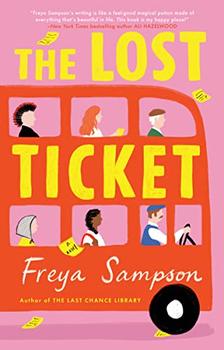Summary | Excerpt | Reviews | Beyond the Book | Read-Alikes | Genres & Themes | Author Bio

This article relates to The Lost Ticket
 In Freya Sampson's novel The Lost Ticket, Titian's Bacchus and Ariadne is a central motif. The painting first comes up in a conversation between the character Frank and an admirer he encounters on the London 88 bus, and it continues to reflect relationships between characters throughout. The mythological relationship between Bacchus and Ariadne, as shown in the painting, symbolizes how love between two people can have an immortal quality. Knowing the mythology behind this work of art can provide a deeper understanding of how love is portrayed in the novel.
In Freya Sampson's novel The Lost Ticket, Titian's Bacchus and Ariadne is a central motif. The painting first comes up in a conversation between the character Frank and an admirer he encounters on the London 88 bus, and it continues to reflect relationships between characters throughout. The mythological relationship between Bacchus and Ariadne, as shown in the painting, symbolizes how love between two people can have an immortal quality. Knowing the mythology behind this work of art can provide a deeper understanding of how love is portrayed in the novel.
First, if you aren't well-versed in Greek mythology, you might be wondering exactly who Bacchus and Ariadne are. Ariadne, a goddess of fertility, is mainly known for her critical role in assisting the hero Theseus in slaying the Minotaur — the offspring of a bull and Ariadne's mother — and guiding him out of the labyrinth where the beast was kept. According to some versions of the myth, after receiving her help, Theseus abandoned Ariadne on the island of Naxos, where she was rescued by Bacchus, the god of wine (otherwise known as Dionysus); he discovered her as she was sleeping and fell in love with her. In some versions of the myth, the two married and had children.
Bacchus and Ariadne is a High Renaissance, dynamic, beautiful piece: rippling fabric wraps around the main subjects, bodies contort in motion and — most notably — it shows Bacchus and Ariadne looking at each other. This is particularly interesting because, according to the Greek myth, Bacchus first saw Ariadne while she was asleep on the island of Naxos. So maybe the scene of their encounter in the painting is set moments after her rest? What makes the work more interesting is that some Roman depictions of the two characters equate Ariadne's sleep with death. So it is possible to interpret the myth as saying that Ariadne was dead by the time Bacchus saw her and fell in love with her.
Many other depictions of Bacchus and Ariadne include tragic imagery. Ariadne is often sleeping, and in some renditions, she lies her head in the lap of Thanatos, the god of death. Positive renditions sometimes point to Bacchus rescuing Ariadne from death, or of the two experiencing immortal love.
Titian's painting could be seen as a celebration of this immortal love. Ariadne is awake, possibly resurrected, as she meets Bacchus's eye. Bacchus's expression is ambiguous, but it could be read as a combination of surprise and enamorment; finally, his yearning for Ariadne has been answered, and he can live joyously with her. The painting also displays a crown of stars in the sky, which appears in the myth as a wedding gift from Bacchus to Ariadne.
Bacchus and Ariadne lived full lives independent of each other, much like the couples in The Lost Ticket. Nonetheless, the duo was eternally united. Regardless of how you interpret Titian's painting or which version of the myth you appreciate, their love persists throughout it all.
Titian's Bacchus and Ariadne (The National Gallery, London)
Filed under Music and the Arts
![]() This article relates to The Lost Ticket.
It first ran in the October 5, 2022
issue of BookBrowse Recommends.
This article relates to The Lost Ticket.
It first ran in the October 5, 2022
issue of BookBrowse Recommends.






Your guide toexceptional books
BookBrowse seeks out and recommends the best in contemporary fiction and nonfiction—books that not only engage and entertain but also deepen our understanding of ourselves and the world around us.